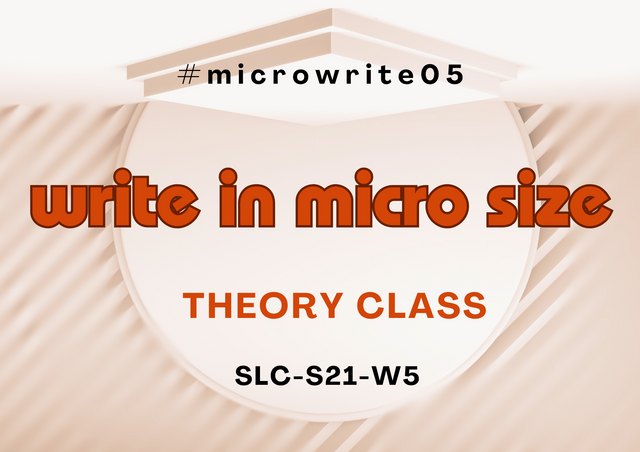 |
|---|

Welcome #Microwriters
Microwriter 's toolbox Theory Lesson
Access the TASK of the fifth week

What is a micro story?
Let's go back to the definition given by GINÉS S. CUTILLAS of the micro story.
«MICRO-STORY: | «MICRORRELATO: |
|---|
Note that each of these characteristics that we have been working on in this Short Literature workshop is contained in said definition.

But first, let's put things into context:
This week we will focus on some keys concepts:
—To omit, suggest, compare, be ambiguous — | — Omitir, sugerir, comparar, ser ambiguos — |
|---|
These are the fundamental processes for creating microfiction. Let's develop them further.
Limiting the number of words in a micro-story has required you to use language precisely and to be more concise in how you use the number of words set by the teachers, over the course of 4 weeks.
In this fifth week, we will explore other literary resources that, although they help with conciseness, also contribute to giving elegance and beauty to the micro-stories you write. They enrich them in form and meaning and also involve the reader, inviting them to participate in the construction of the story.

The main resources to use are:
Narrative ellipsis, metaphor and multiple meanings.
1. The power of omission and suggestion: Narrative ellipsis
With ellipsis we practically omit or eliminate, voluntarily, words or phrases from a sentence without losing the meaning. This creates a void of meaning that the reader's mind will fill or complete, in addition to the forcefulness that it gives to the discourse.
It can be used in two ways: by not writing words that are understood, or by constructing phrases and sentences in a way that “suggests” what is not being said.
Example: [1]
He came in. He closed the door. He sat down. With a face...! | Entró. Cerró la puerta. Se sentó. ¡Con una cara...! |
|---|
Almost in telegram mode, here I make use of the implicit subject, eliminating adjectives and complements, leaving the essential elements of the sentence. The last three words suggest an emotion. What do you think it is, the emotion I don't name?
Let's look at another example, attributed to Ernest Hemingway
For sale: baby shoes, never worn. | En venta: zapatos de bebé, nunca usados. |
|---|
What information does the author omit or not mention, that you must fill in? What images and emotions did it bring to your mind when you read it? How did you fill in what the author didn't say?

2. The power of comparison: The Metaphor
When we use a metaphor, we compare two different elements that share some common characteristic.
Example: [1]
I saw his eyes, two oceans of deep sadness. | Vi sus ojos, dos océanos de profunda tristeza. |
|---|
Here, I compare the eyes to two oceans. I don’t mention emotion or tears when I see their eyes, but I use the phrase “deep sadness” which brings me back to the depth of the oceans, which makes “sadness” very deep.
As a practice, you can use “HOW or AS IF” to help you recognize the two objects being compared.
Example: [1]
As in reality, the ground is the best parachute. | Tal como la realidad, el suelo es el mejor paracaídas. |
|---|
If you look at it, there are several resources here: do you find the metaphors? There are at least two, one is “ground and parachute”, the other is suggested. I also play with the meaning of “parachute”, which is the next resource to use.

3. The power of wordplay: Double and multiple meanings
Giving words or phrases a different meaning opens us up to the multiple meanings and interpretations they can have in different contexts. This resource opens us up to the ambiguity of meanings and expands the power of the micro-story. The above metaphor can be used as an example of double meaning, let's look at others.
Example: [1]
Canned historyPost data Mr. Editor Your last telegram is already bordering on cynicism, on madness. Condense my story?!! Put my life in a can? Is that what you are asking me? Go and condense ....!! | Historia EnlatadaPost data Sr. Editor Su último telegrama, ya raya en el cinismo, en la locura. ¡¡¿Qué condense mi historia?!! ¿Qué meta mi vida en una lata? ¿Es eso lo que me está pidiendo? ¡¡Vaya usted a condensar al ....!! |
|---|
( See the letter that generates this post data ) [1]
In this example I play with the meaning that can be attributed to the word “story” when a writer and his editor converse. But there is a deeper meaning, which is “ my story” as “my life .” I exaggerate this ambiguity with the metaphor of a can (condensed milk) and putting life in a can. And in the end it is understood (I omit it) the bad word that I send to the editor. (At least in Spanish)
Another example:
Menaces: | Amenazas: |
|---|
Autor: William Ospina
An example of extreme conciseness, metaphors and play with the meaning of “devouring (swallowing) a sword.”
We invite you to do your own research on other narrative resources that you can use in writing micro-stories. Here we only mention a few, and these others: Hyperbole, the art of exaggeration, irony, the use of oxymorons. And get inspired by micro-stories from other authors, there are many on the web.

Delves deeper into the subject of narrative ellipsis:

Summary
As Microwriters , it's good to have a toolbox of literary devices to apply to your stories. Devices like ellipsis, metaphor, and double entendre will help you to give greater richness of meaning, make them more impactful, and especially, actively involve the reader in the construction of meaning.
Access the TASK of the fifth week


Notes:
- [1] Micro-story by @joslud.
- Images created on canva.com

 Original production by @joslud |